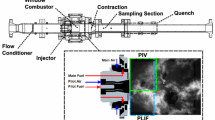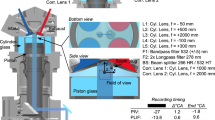Abstract
High-resolution planar laser-induced fluorescence (PLIF) measurements were performed in an optically accessible internal combustion engine to investigate the evolution of the turbulent mixing process during the intake and compression strokes. The PLIF measurements were used to analyze the important turbulent length scales, scalar energy and dissipation spectra, and mean scalar gradients. The fluorescence images had sufficient spatial resolution and integrity to resolve all of the fine-scale features of the flow, allowing for direct determination of the Batchelor length scale. The integral and Taylor scales were also determined from two-point spatial correlations of the fluctuating scalar field using an appropriately defined mean scalar value. The general morphology of the scalar field and the measured integral, Taylor and Batchelor length scales were found to be largely independent of engine speed and intake pressure, but increased as the engine cycle progressed through the intake and compression strokes. The measured Batchelor scales ranged from 22 to 54 μm; the integral scales ranged from 1.8 to 3.5 mm; and the Taylor microscales ranged from 0.6 to 1.2 mm. The Taylor and integral scale values were comparable to values reported in the literature from in-cylinder velocity measurements. The mean scalar gradient, a measure of the fine-scale mixing rate, monotonically decreased as the engine cycle advanced. High-resolution measurements of this type are important in the development and validation of future engine combustion models used in computer simulations.










Similar content being viewed by others
References
Antonia R, Abe H, Kawamura F (2009) Analogy between velocity and scalar fields in a turbulent channel flow. J Fluid Mech 628:241–268
Batchelor G (1959) Small-scale variation of convected quantities like temperature in turbulent fluid. Part 1. General discussion and the case of small conductivity. J Fluid Mech 5:113–133
Bilger R (1989) Turbulent diffusion flames. Ann Rev Fluid Mech 21:101–135
Buch K, Dahm W (1996) Experimental study of the fine-scale structure of conserved scalar mixing in turbulent shear flows. Part 1. Sc ≫ 1. J Fluid Mech 317:21–71
Buch K, Dahm W (1998) Experimental study of the fine-scale structure of conserved scalar mixing in turbulent shear flows. Part 2. Sc ~ 1. J Fluid Mech 364:1–29
Dent J, Salama N (1975) The measurements of the turbulence characteristics in an internal combustion engine cylinder. SAE Technical Paper 750886
Dinsdale S, Roughton A, Collings N (1988) Length scale and turbulence intensity measurements in a motored internal combustion engine. SAE Technical Paper 8803380
Düwel I, Koban W, Zimmerman F, Dreier T, Schulz C (2009) Spectroscopic characterization of the fluorobenzene/DEMA tracer system for laser-induced exciplex fluorescence for the quantitative study of evaporating fuel sprays. Appl Phys B 97:909–918
Frank J, Kaiser S (2008) High-resolution imaging of dissipative structures in a turbulent jet flame with laser Rayleigh scattering. Exp Fluids 44:221–233
Fraser R, Bracco F (1988) Cycle-resolved LDV integral length scale measurements in an IC engine. SAE Technical Paper 880381
Fraser R, Bracco F (1989) Cycle-resolved LDV integral scale measurements investigating clearance height scaling, isotropy, and homogeneity in an IC engine. SAE Technical Paper 890615
Funk C, Sick V, Reuss D, Dahm W (2002) Turbulence properties of high- and low-swirl in-cylinder flows. SAE Paper 2002-01-2841
Ghandhi J (2006) Spatial resolution and noise considerations in determining scalar dissipation rate from passive scalar image data. Exp Fluids 40:577–588
Glover A, Hundleby G, Hadded O (1988) The development of scanning LDA for the measurement of turbulence in engines. SAE Technical Paper 880378
Herold R, Ghandhi J (2007) Investigation of bulk in-cylinder stratification with split intake runners. SAE Technical Paper 2007-01-4044
Herold R, Ghandhi J (2008) Data normalization schemes for assessing mixture stratification from PLIF data. SAE Technical Paper 2008-01-1070
Herold R, Krasselt J, Foster D, Ghandhi J, Ruess D, Najt P (2009) Investigations in the effects of thermal and compositional stratification on HCCI combustion—part 1: optical engine results. SAE Technical Paper 2009-01-1106
Kaiser S, Frank J (2007) Imaging of dissipative structures in the near field of a turbulent non-premixed jet flame. Proc Comb Inst 31:1515–1523
Kaiser S, Frank J (2011) The effects of laser-sheet thickness on dissipation measurements in turbulent non-reacting jets and jet flames. Meas Sci Technol 22:045403
Kolmogorov A (1962) A refinement of previous hypotheses concerning the local structure of turbulence in viscous incompressible fluid at high Reynolds number. J Fluid Mech 13:82–85
Kothnur P, Clemens N (2001) Experimental investigation of the relationship between strain and scalar dissipation in gas-phase turbulent jets. AIAA 2001-1023
Mi J, Nathan G (2003) The influence of probe resolution on the measurement of a passive scalar and its derivatives. Exp Fluids 34:687–696
Miles P, Megerle M, Nagel Z, Reitz R, Lai M-C, Sick V (2003) An experimental assessment of turbulent production, Reynolds stress and length scale (Dissipation) modeling in a swirl-supported DI diesel engine. SAE Technical Paper 2003-01-1072
Obukhov A (1962) Some specific features of atmospheric turbulence. J Fluid Mech 13:77–81
Petersen B, Ghandhi J (2009) High resolution scalar dissipation measurements in an IC engine. SAE Int J Engines 2(1):475–491
Petersen B, Ghandhi J (2010) High resolution scalar dissipation and turbulence length scale measurements in an internal combustion engine. SAE Int J Engines 3(1):65–83
Petersen BR, Heim DM, Ghandhi JB (2010) High-resolution scalar and velocity measurements in an internal combustion engine. J Eng Gas Turbines Power 132(9):092804. doi:10.1115/1.4000603
Pope S (2000) Turbulent flows. Cambridge University Press, Cambridge
Rehm J, Clemens N (1999) The association of scalar dissipation rate layers and OH zones with strain, vorticity, and 2-D dilatation fields in turbulent nonpremixed jets and jet flames. AIAA 99-0676
Siegman A (1998) How to (Maybe) measure laser beam quality. OSA TOPS 17:184–199
Siegman A, Sasnett M, Johnston T (1991) Choice of clip levels for beam width measurements using knife-edge techniques. J Quantum Elect 27:1098–1104
Su L (1998) Measurements of the three-dimensional scalar dissipation rate in gas-phase planar turbulent jets. Center for Turbulence Research Annual Briefs
Su L, Clemens N (1999) Planar measurements of the full three-dimensional scalar dissipation rate in gas-phase turbulent flows. Exp Fluids 27:507–521
Su L, Clemens N (2003) The structure of fine-scale scalar mixing in gas-phase planar turbulent jets. J Fluid Mech 488:1–29
Tsurikov M, Clemens N (2002) The structure of dissipative scales in axisymmetric turbulent gas-phase jets. AIAA 2002-0164
Wang G, Barlow R (2008) Spatial resolution effects on the measurement of scalar variance and scalar gradient in turbulent nonpremixed jet flames. Exp Fluids 44:633–645
Wang G, Clemens N (2004) Effects of imaging system blur on measurements of flow scalars and scalar gradients. Exp Fluids 37:194–205
Wang G, Barlow R, Clemens N (2007a) Quantification of resolution and noise effects on thermal dissipation measurements in turbulent non-premixed jet flames. Proc Comb Inst 31:1525–1532
Wang G, Clemens N, Barlow R, Varghese P (2007b) A system model for assessing scalar dissipation measurement accuracy in turbulent flows. Meas Sci Technol 18:1287–1303
Wang G, Karpetis A, Barlow R (2007c) Dissipation length scales in turbulent nonpremixed jet flames. Comb Flame 148:62–75
Wiles M, Probst D, Ghandhi J (2005) Bulk cylinder flowfield effects on mixing in DISI engines. SAE Technical Paper 2005-01-0096
Author information
Authors and Affiliations
Corresponding author
Rights and permissions
About this article
Cite this article
Petersen, B., Ghandhi, J. High-resolution turbulent scalar field measurements in an optically accessible internal combustion engine. Exp Fluids 51, 1695–1708 (2011). https://doi.org/10.1007/s00348-011-1178-z
Received:
Revised:
Accepted:
Published:
Issue Date:
DOI: https://doi.org/10.1007/s00348-011-1178-z




